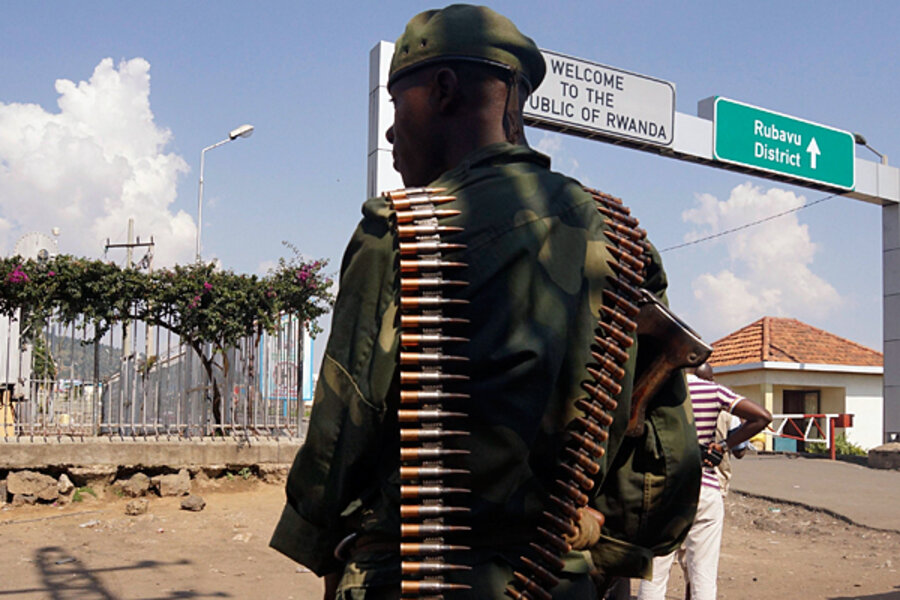In East Congo, high drama as long war begins to end
Loading...
A version of this post originally appeared on Congo Siasa blog. The views expressed are the author's own.
The new round of fighting between Congolese government forces and the M23 rebels is reaching a dramatic climax.
With the Congolese army having swept through all of the major towns that the M23 held -- Kibumba, Rumangabo, Rutshuru, Kiwanja, and, since this afternoon Bunagana -- the M23 may be nearing its end.
This would be historic. It would be the first time the Congolese government had defeated a major rebellion, and it would be the first time since 1996 that an armed group allied to Rwanda is not present in the eastern Congo.
It is, however, too soon, to declare an end to the M23, as the rebels reportedly still occupy the hills along the Rwandan border between Runyoni and Tshanzu.
How did we get here?
The fighting began last Friday morning on the southern front line, in the area of Kibumba. The resumption of hostilities was not surprising, given that the peace talks in Kampala had fallen apart several days prior.
The following day, the Congolese Army began a simultaneous offensive on the M23's northern flank where the army had been massing troops and weapons for several months. Progress was quick. By Saturday, the Army had taken control of Kibumba and on Sunday Kiwanja was under their control.
By Sunday, the army advanced to Rumangabo, the M23's military base, and Rutshuru, the territorial capital.
Today, {Oct. 30] they took back Bunagana on the Ugandan border, where the M23's political leaders had been staying. After heavy bombardment, Congolese troops were already reported to have scaled the Mbuzi hill and were trying to close in on Runyoni and Tshanzu.
Africa Defence Review has a summary of the fighting, with a helpful map here.
The fighting was heaviest around Kibumba, where the M23 put up a fight and both sides lost troops. Elsewhere, there seems to have been little resistance by the thinly-stretched M23. Reports put their total fighting force between 800 and 1,500 troops.
By Tuesday, there were rumors that their military commanders had fled to neighboring Uganda or Rwanda, although none of these could be verified.
But why did this round of fighting turn out so differently than previous ones?
How could the Congolese army, usually better known for its indiscipline and racketeering than its military prowess, knock the M23 out so quickly?
Three factors were key, even if the paramount factor is different to discern for now:
There is no doubt that the FARDC is performing much better now than in 2012. Its command structure has been changed and streamlined, beginning with the appointment of General Lucien Bahuma as regional commander in June 2012, and of General François Olenga as land forces commander in December 2012.
These commanders have paid more attention to making sure logistics were in place and salaries paid on time, boosting soldiers' morale and enabling the newly-trained commando battalions to do their job. Then, in January 2013, over a hundred officers -- many of them from the Kivus -- were invited to Kinshasa under the pretext of a seminar on army reform (they are mostly still in Kinshasa today).
This simplified the military hierarchy in North Kivu, which had become clogged up with competing chains of command, a coterie of high-ranking officers embezzling funds and issuing contradictory orders.
The second factor was the United Nations: Observers on the front lines reported that the Congolese soldiers were being issued military rations by the UN, and that UN officers were jointly planning operations with the Congolese army. UN attack helicopters have been providing support, although the bulk of the fighting has been carried out by the FARDC.
But the third factor may be the determining one: the absence of support from Rwanda. According to several reports from the front lines, despite indications of some cross-border support in the Kibumba area, the M23 was largely left to its own devices.
"The Rwandans just wouldn't pick up their phone calls," one source close to the M23 leadership told me.
This is a drastic change from August, when many sources -- the UN, Human Rights Watch, and foreign diplomats -- all reported hefty support coming across the border. The fact that the M23 did not put up much of a fight in Kiwanja and Rumangabo was another indication that they knew they stood no chance against the superior firepower of the UN and the FARDC.
According to several diplomats, US Secretary of State John Kerry as well as a senior British diplomat called President Paul Kagame last Friday to impress how important it was for Rwanda to sit this out.
While similar pressure has been applied before -- President Obama called his Rwandan counterpart with a similar message last December -- this time it may have just been the final straw for the Rwandan leaders.
The coming days will be interesting. If the M23 is defeated, the Rwandan, and possibly the Ugandan governments will have to decide whether they will arrest the fleeing leaders or give them amnesty.
The Congolese army will be under scrutiny to see how they manage their victory. Any revenge attacks or targeting of suspected M23 collaborators could spoil the mood, and many will wait to see if they proceed to target the FDLR as promised.
Finally, the impact of a victory on the larger peace process in the region would be powerful. President Kabila, who signed the Framework Agreement last February largely due to pressure from the M23, could shake off some of the pressure on him to carry out national reforms and would be buoyed by the popularity such a victory would certainly bring.
For the moment, however, we should wait to see what the coming days bring.







